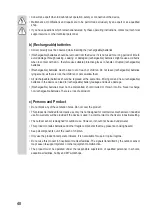
46
8. Initial setup and mounting
Read the following information carefully to ensure that the weather station and outdoor sensor are positioned correctly.
a) Wireless range
The maximum range of the wireless signal is 100 m in ideal conditions with no obstructions. In reality, the range is
likely to be lower due to obstructions such as walls and trees. However, the range should be sufficient for use in a
detached home. If the weather station does not receive readings from the outdoor sensor, try reducing the distance
between the two devices. The range can be reduced considerably by:
• Walls and reinforced concrete ceilings
• Double glazed or aluminium windows
• Vehicles
• Trees, bushes, soil and rocks
• Proximity to metallic or conductive objects (e.g. radiators)
• Proximity to people
• Signal interference (e.g. cordless and mobile phones, wireless headphones and speakers, other weather stations
that operate on the same frequency, and baby monitors).
• Proximity to electric motors, transformers and power adapters
• Proximity to mains sockets and cables
• Proximity to computers or other devices with exposed or poorly insulated components
The following table shows the effect that different materials have on wireless transmission when placed between the
weather station and the sensor.
Obstacle
Reduction in signal strength (in %)
Glass (not wired or metal-coated)
5 - 15 %
Plastic
10 - 15 %
Wood
10 - 40 %
Brick
10 - 40 %
Concrete
40 - 80 %
Metal
90 - 100 %
Ensure that the outdoor sensor is exposed to direct sunlight so that the solar cell can generate electricity
and measure the light intensity. The sensor must be exposed to the sky to ensure that the precipitation
is measured accurately. There should be no obstacles in the immediate vicinity. Wind must be able to
blow onto the wind sensors on all sides to ensure accurate wind readings. Avoid areas with downdrafts or
turbulence (e.g. behind chimneys).






























